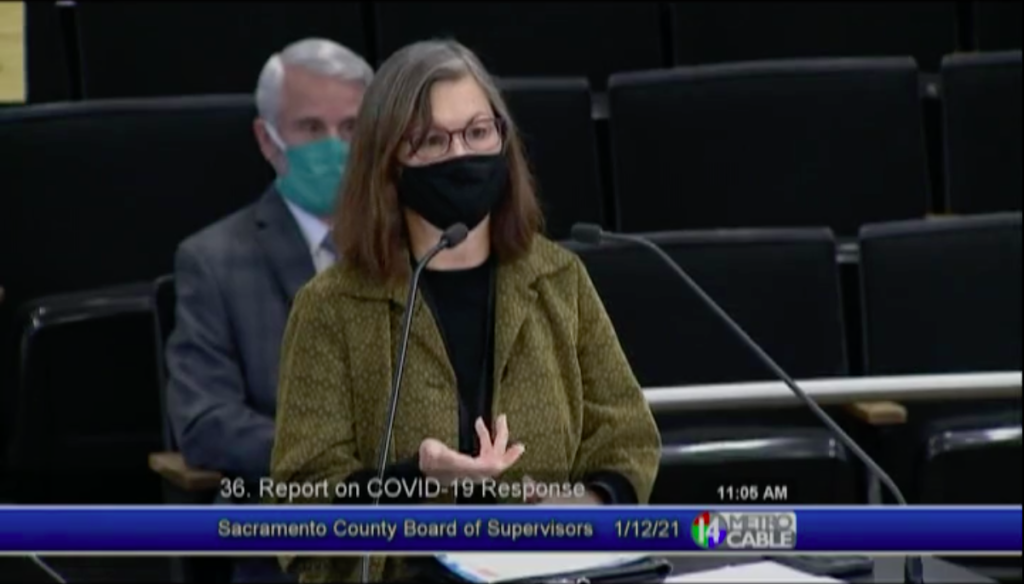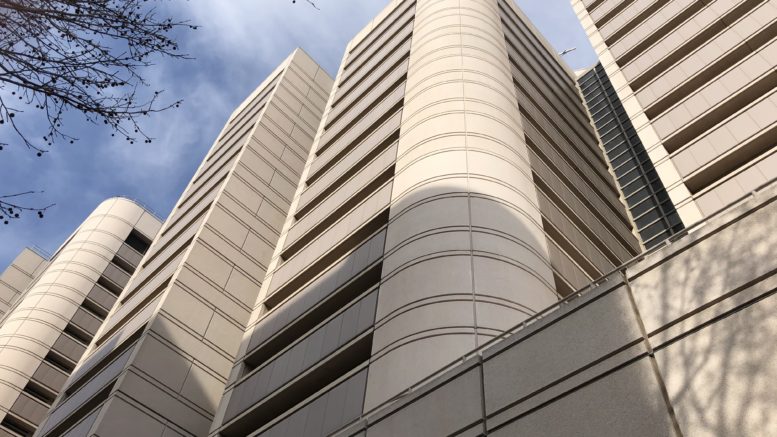Infections are soaring inside Sacramento’s jails—just as advocates predicted
A COVID-19 outbreak is sweeping through Sacramento County’s jail system, just as attorneys and advocates for the incarcerated warned it would if the sheriff’s office didn’t take stricter precautions.
As of Jan. 13, 293 people in either the downtown jail or the Rio Cosumnes Correctional Center near Elk Grove were infected with the virus, representing a 72% increase in two weeks.
“Our numbers have really increased,” Adult Correctional Health Director Sandy Damiano told county supervisors on Jan. 12. “We went from zero people with coronavirus at the branch jail to 58 to 100-plus, and now we’re going to be over that.”
Damiano explained the outbreak was first detected Dec. 30, after the sheriff had already transferred three busloads carrying dozens of untested inmates from the downtown jail to Rio Cosumnes. When several of the transported inmates came down with flu-like symptoms, they were tested for what public health officials confirmed was the coronavirus. That started contact tracing efforts, but by then the virus was already racing around the dormitory-style branch jail.
“Almost all of the patients are asymptomatic,” Damiano told supervisors. “No one has been hospitalized. There have been no deaths that have occurred.”
But the health professional added that upward of 400 incarcerated people still needed to be tested and described the situation as being in “active outbreak mode.”
Sacramento County Sheriff Scott Jones has kept a tight lid on information escaping his jails. Unlike most California sheriffs, he refuses to provide COVID-19 infection data directly to the state and instead releases weekly updates on the office’s website.
Jones’ lack of transparency and the California Board of State and Community Corrections’ reluctance to challenge him is putting more people at risk, advocates for the incarcerated say.
“Looking at those jail numbers and what’s happening with COVID, it’s frightening,” said Brian Goldstein, director of policy and development at the Center on Juvenile and Criminal Justice in San Francisco. “And the question is, what is the state going to do? How is the state going to protect the people inside? We’ve been asking that question since the pandemic began.”
Mixed messages, increased despair
The sheriff’s office paused in-person visitations at Rio Cosumnes “due to Covid-19 concerns” on Dec. 30. That’s the date the office says staff learned that 55 inmates transported from the downtown jail to Rio Cosumnes had COVID-19. Two more transports occurred before the results were known and contract tracing efforts began.
Since March of last year, a total of 811 people booked into jail have tested positive for COVID-19. By comparison, only 101 positive cases existed on Sept. 30, according to court documents.
Less than 10% of COVID-19 infections were detected at the time an inmate was booked into the facility or isolated in quarantine, meaning the vast majority of infected inmates spent time around other jail occupants and staff.
A sheriff’s spokesman downplayed the sudden spike in infections, telling The Sacramento Bee it was due to an increase in testing, but the numbers don’t bear that out. Between Dec. 30 and Jan. 13, testing increased only 16% while positive cases rose 57%.
A year in, we’re doing the “more testing means more cases” dance again and totally missing the point.
— Jason Pohl (@pohl_jason) January 12, 2021
COVID cases at Sacramento County Main Jail more than triple in last week, lawyers say https://t.co/iLBdPslsJI pic.twitter.com/0XYHHhFy4Y
Decarcerate Sacramento has been pressing the sheriff’s office and Sacramento Superior Court to decrease the jail population more aggressively. More than 400 inmates with two months left on their sentences were released last spring; the sheriff’s office received recent court approval to release another 178 inmates with three months left beginning Jan. 11.
The population of the two jails stood at 3,166 on Jan. 13, a 2% decrease since Dec. 30.
“Confining people and involuntarily exposing them to hazardous situations in which they may contract a deadly virus is not only unethical; it is cruel and unusual,” Phil Summers, a local emergency medicine physician, said in a statement provided by Decarcerate Sacramento.
Conditions inside the jail have already fomented despair.
Newly obtained data reveals that 23 inmates attempted suicide last year, the most attempts since at least 2008. All but one attempt occurred in the downtown jail.
The sheriff’s office says none of the suicide attempts resulted in death, but six people did die behind bars last year, according to public records obtained by SN&R.
Three deaths remain under investigation, while two were deemed to be the result of “natural” causes, including that of Gonzalo Ruiz Garcia, a 55-year-old Latino man who was awaiting trial in the county jail on a federal drug charge. He died in a local hospital in November. Gary Hollis Hamlin, age 77 and white, was also reported to have died of natural causes last January, while awaiting trial inside the jail for allegedly sexually assaulting a severely disabled or medically incapacitated person.
Antonio Lamar Thomas was in jail for an alleged probation violation when an inmate beating caused his death in a hospital on Jan. 21, 2020, roughly one month before the Black man’s 40th birthday.
Of the jail deaths still being investigated, the victims are:
- Travis Mitchell Welde, 31 and white, awaiting trial for possession of a controlled substance, was in a living area of the county jail when the undisclosed event that caused his Aug. 4 death occurred.
- Herman Johnson, 41 and Black, awaiting trial for attempted murder, was also in a living area of the jail when an undisclosed event caused his death on Aug. 11, one week after Welde died.
- Michael Bazley, 71 and Black, awaiting trial for domestic violence, was in a medical treatment facility of the jail when an undisclosed event caused his death on Nov. 9.
Welde’s mother told SN&R her son died of a heart attack with several drugs in his system—two weeks after he entered the jail. She suspects he didn’t receive the withdrawal medication he needed and was instead left in an isolation cell to come down from a serious heroin addiction.
“Things just don’t add up,” DeAnn Welde said of what sheriff’s officials have told her about her son’s death. “I’m not looking for money. I just want justice. I’m hoping no other parent loses their kid in there.”

Let them eat zinc
The six jail casualties last year actually represent an improvement for the Sacramento County Sheriff’s Office. Nine incarcerated people died in 2019, marking the deadliest year for the jail system under Sheriff Jones’ decade-spanning command.
Assemblyman Kevin McCarty of Sacramento told SN&R last summer that the county doesn’t just have a moral reason to be concerned about the care of its jail inmates, most of whom haven’t been tried for their alleged crimes. He noted that jail conditions can cause expensive lawsuits.
“That’s always a big piece with oversight, our county jails,” the Democratic lawmaker said.
Sacramento County paid $40.7 million to settle claims against its sheriff’s office in 2018 and 2019, SN&R reported last month.
The coronavirus has deeply complicated the county’s ability to address a number of preexisting problems, including the lack of medical and psychiatric care.
Some inmates wrote letters complaining that they’ve been in solitary confinement for 10 to 22 months, according to a status report filed last month in federal court. The report was issued as part of the settlement of a 2018 class action lawsuit assailing the jails for violating constitutional protections against cruel and unusual confinement.
The county last year estimated it would cost more than $100 million to meet the needs of mentally ill and disabled people inside its jails.
Decarcerate Sacramento is pushing for mass emergency releases and keeping the local jail population low.
“We know that the county—as a result of COVID-19—reduced the jail population over 30% without any significant increase in crimes,” Tifanei Ressl-Moyer, an attorney with Lawyers Committee for Civil Rights, told SN&R last fall. “From our perspective, the only way to keep people safe is to continue to reduce the population.”
Damiano told county supervisors last Tuesday that all medical staff working in the jails would be vaccinated against the coronavirus by Jan. 15 and that correctional staff were next in line. Medically vulnerable inmates would receive vaccinations depending on availability, she said.
That’s when Supervisor Sue Frost, a borderline COVID-19 skeptic, spoke up.
“Are we giving them vitamin C, D and zinc?” she asked Damiano. “They say that boosts your immune system.”
“No,” the physician quickly responded.
“We should,” Frost said.
Damiano made a noise with her throat. It sounded like shocked laughter.






Be the first to comment on "Welcome to COVID jail"